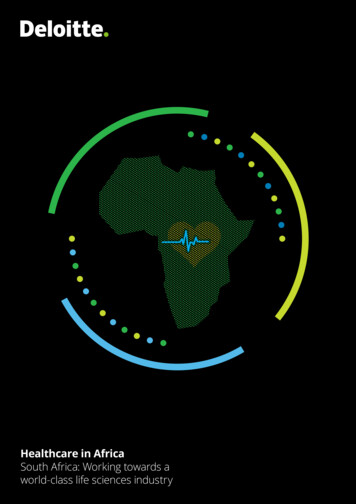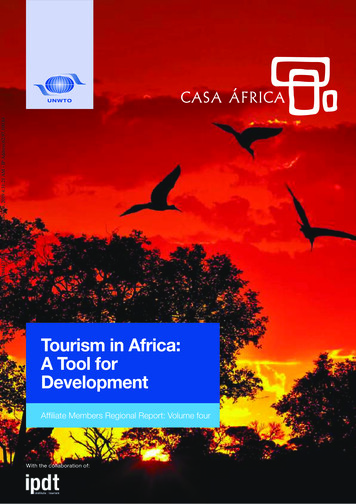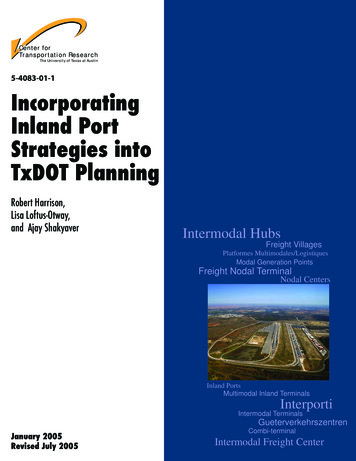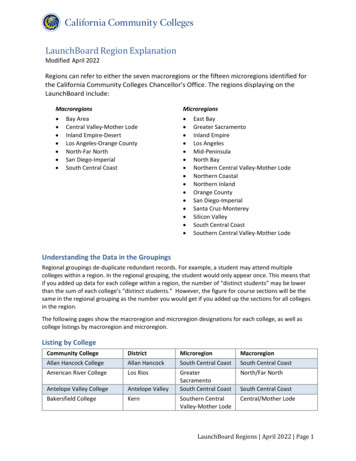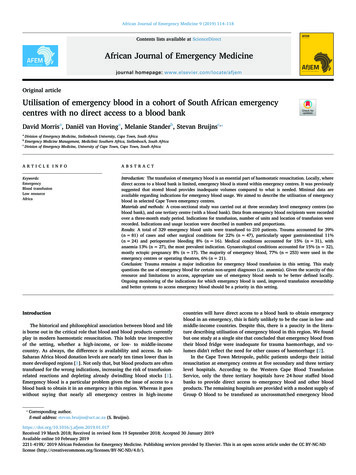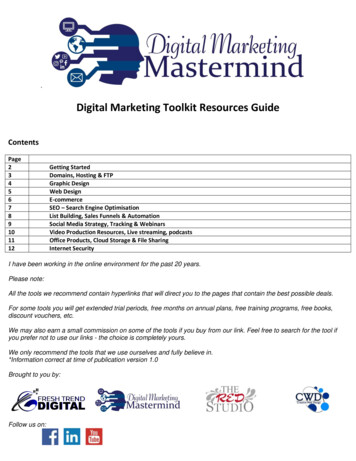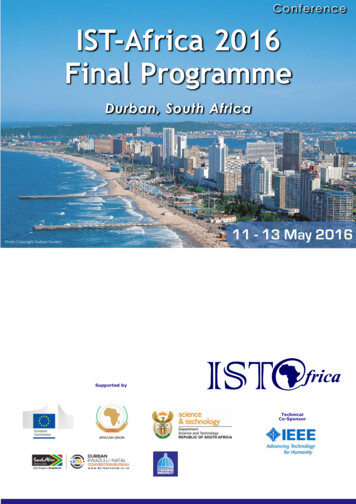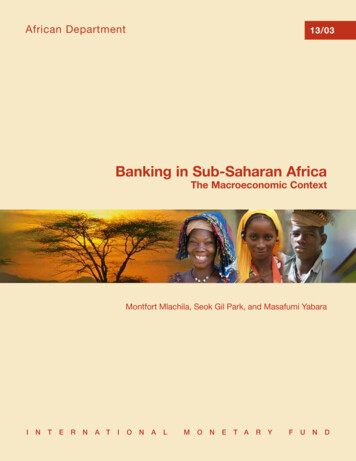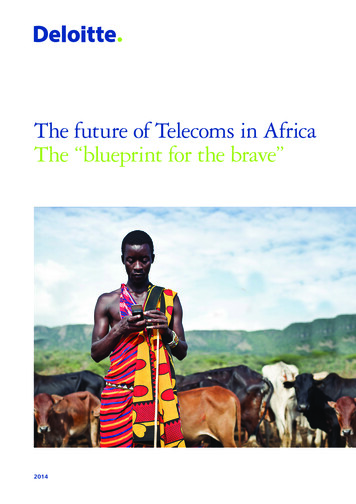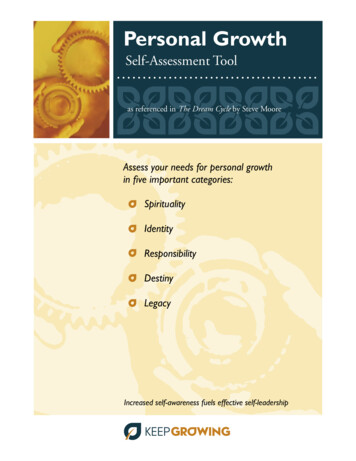
Transcription
Personal GrowthSelf-Assessment Toolas referenced in The Dream Cycle by Steve MooreAssess your needs for personal growthin five important nyLegacyIncreased self-awareness fuels effective self-leadership
2004 by Steve Moore,Published by Keep Growing Inc.All rights reserved. Permission to copy is granted for personal use only.
Personal Growth Assessment ToolGetting StartedThe term assessment sounds technical, and some aspects of a growth assessmentare. But there is an underlying, internal aspect to self-assessment that is far morevaluable than any resource you could purchase. Effective self-assessment hinges onself-awareness. You cannot assess what you do not see. Before you can effectively assessyourself, you must cultivate a high level of self awareness.The first level of self awareness is being honest about yourself with yourself. Thesecond is being honest about yourself with others. Both levels are essential, and they aresequential. You cannot move to the second if you have skipped the first. The hallmark ofself-awareness is a deep understanding of your emotions, strengths, limitations, values,and motives. This requires a high-octane mixture of honesty and humility. A watereddown view of reality simply will not do. The cultivation of self-awareness requiresself-confidence and personal security reinforced by a grace-awakened, high-trustenvironment.(Excerpted from page 104, of The Dream Cycle, by Steve Moore.)Five Assessment CategoriesThis tool is intended to help you cultivate greater self-awareness in five categories,which in turn will help you analyze the most strategic areas for personal growth in yourcurrent growth cycle. The five areas are: Spirituality: your character, values and moral center Identity: your personality, talents, skills, giftedness, passions and dreams Responsibility: your life domains including personal, family, vocational andcommunity involvement Destiny: your unique purpose as defined by your life mission Legacy: what you will leave behind and how you will be rememberedFinal InstructionsDon’t rush through this process. Some people find it helpful to work on one categoryper day from Monday through Friday and then spend a weekend reflecting on theiranswers. Others expand this process over the range of an entire month. Whatever youdecide, take your time; the process will affect the results.Reflect on and answer the questions listed in each of the five assessment categories.1You may consider using a numeric scale (1-10) or simply jot down comments for eachquestion. For each category, highlight the top three areas in which you sense thegreatest need for attention in this growth cycle.Increased self-awareness fuels effective self-leadership1
Personal Growth Assessment ToolCategory 1: SpiritualityA vibrant and growing relationship with God is the foundation for effectiveness in allof life. More than talents, gifts, or training, the powerful presence of God in the life of aleader is the essential ingredient for realizing dreams and creating a lasting legacy.Inner Life. Is my inner life centered on God, and am I fully surrendered to Hisleadership? Are there areas of my life where I am pursuing an agenda that I know is nothonoring to God or in accordance with His plan for me?Private Life. Do I have a growing, experiential relationship with God and a clearunderstanding of which activities stimulate this relationship? What devotional habitsor components of a spiritual training program are most helpful to me in cultivatingintimacy with God? How consistently do I practice these spiritual growth habits?Public Life. Does my daily life bear witness to the inner relationship I have with God,showing a consistent pattern in my lifestyle? Is there a credibility gap between myprivate and public life?Relational Life. Do I have a growing network of meaningful relationships, especiallywith those who share my faith? How consistently am I experiencing the power of bodylife by giving or receiving prayer, confession, exhortation, and encouragement?Spiritual Sensitivity. Do I recognize and respond to the promptings of God’s Spirit,which heighten my sense of His presence and release His power in me? Is it natural andreflexive for me to engage in worship both privately and corporately?Ministry Fruitfulness. Is my life fruitful in that my character is developing and I amusing my giftedness in serving others? Am I involved in both formal (connected to anorganization) and informal (self-directed) service to others that is both effective andfulfilling?Increased self-awareness fuels effective self-leadership2
Personal Growth Assessment ToolCategory 2: IdentityIdentity may be the most comprehensive category for personal assessment. Most ofyour capacity issues will flow from the six components of your Identity Profile.Personality. What is my natural personality bent and how well do I understand it?How readily do I use the understanding of my personality to frame how I makedecisions or interact with other people? (Note: It is difficult to assess this areawithout the help of a specialized assessment tool.)Passions. How do I naturally respond to challenges and opportunities? What interestsor issues am I self-motivated to learn more about, participate in, recruit others for, orpay a price to pursue? What experiences in my past have captured my attention, stirredmy emotions, and roused me to action? In what situations have I felt most attentive,engaged, and alive?Talents. In what areas have I been naturally gifted? What have I learned to do naturallyand rapidly? Which of these talents have not been developed to their appropriatecapacity? How could I turn these talents into strengths by adding knowledge, skill, andexperience? (Note: The Gallup StrengthsFinder process is an excellent tool for assessingnatural talents. More information is available at http://www.strengthsfinder.com.)Skills. In what skills have I (or do I want to) become proficient? Which of these shouldI develop now? What general interests have I failed to pursue that could open new skillsets for me?Increased self-awareness fuels effective self-leadership3
Personal Growth Assessment ToolSpiritual Gifts. How has God divinely enabled me to serve others? Which of thesegifts should I proactively develop in this growth cycle? (Note: The use of a spiritual giftsassessment tool can be valuable in this process. Talk to your pastor for help in locating atool.)Dreams. Complete or answer the following sentences. When I think about , I quickly see the difference betweenwhat is and what I believe should be; and I feel compelled to do this aboutit: . When I listen to the inner longings God has placed in my heart or the hurts inthe lives of people around me, I feel compelled to . When I think about developing talents, skills and gifts to their full potential, Iimagine myself doing . The picture I have of destiny fulfillment is connected to me being/doing/going.Increased self-awareness fuels effective self-leadership4
Personal Growth Assessment ToolCategory 3: ResponsibilityReview each of the subcategories of responsibility as depicted in the five life domains.Keep in mind that these are not rigidly defined and there is overlap between them.Answer the questions listed below for each life domain.2 Reflect on your answers andidentify the role(s) you feel need proactive attention in this growth cycle. What is good, right, or effective that I should optimize? Is there something wrong, misplaced, or out of balance that I should change? Is there something confusing or frustrating that I should resolve or clarify? Is there something absent that I should add?I my health, emotions, intellect, and general well being.Family Life: my immediate and extended family, including my parents, spouse,children, and other close family relationships.Vocational Life: my career or work, including student or training activities that willprepare me for future employment.Faith Life: my involvement in the broader faith community, including churchand other faith-based organizations.Community Life: my involvement in or connection to the neighborhood, city, orother defined community to which I belong.Increased self-awareness fuels effective self-leadership5
Personal Growth Assessment ToolCategory 4: DestinyThe highest expression of destiny awareness is a personal mission statement. Afterworking through the list of questions below, ask yourself where destiny processing orlife planning belong in your current growth cycle.Mission Statement. Write from memory the working draft of your personal missionstatement, which describes the essence of your destiny as you currently understand it.(Note: If you do not have a personal mission statement, or if you cannot write it frommemory, you should consider including life planning in your current growth cycle.)Mission Assessment. Assess the mission statement written above, using the followingquestions. Is it clear enough to explain why I exist? Is it simple enough to be understood by others with minimal clarification? Is it broad enough to include my whole life, not just my job? Is it noble enough to inspire commitment and sacrifice?Progress Assessment. Assess your progress toward your life mission with the followingquestions. How does my primary vocational and Kingdom role enable me to focus on thislife mission? To what extent am I leveraging my passions and giftedness to focus on mymission? What was the most significant activity during the last growth cycle that enabledme to move toward mission fulfillment? What triggered my involvement in this activity? What measurable progress did I make toward destiny fulfillment in the pastgrowth cycle?Increased self-awareness fuels effective self-leadership6
Personal Growth Assessment ToolCategory 5: LegacyRealizing your God-inspired dreams will have a powerful affect on how you areremembered - your personal legacy. The best way to create a positive legacy is to beginwith the end in mind, envisioning the ultimate contributions that might result from alifetime of faithfulness to your God-inspired dreams.Use the following list of ultimate contribution3 categories to stimulate your thinking.But be open to other categories that come to your mind. Based on your life-dreams, tryto identify the top three ultimate contributions that might shape your legacy.Model Life: a life that inspires others toward commitment and exemplifiesdepth of character and consistency over the long haul.Personal Activity: a profound impact on many individuals resulting from yourinvestment in their lives or active service of others.Public Activity: a profound impact on larger groups of people resulting from yourservice as a public speaker, teacher, or trainer.Creative Activity: a consistent pattern of breakthrough concepts or new ideasthat helped move people or organizations to a new level of productivity.Pioneering Activity: a track record of initiating new structures, giving oversightto them, and, at times, training or identifying others who can take overleadership for you.Mobilizing Activity: a repeated ability to motivate people to get involved in acause, connect them with others, and advance the cause through increasedawareness or results.Artistic Activity: a consistent bent toward including art, music, poetry, or otherartistic elements, in a way that touches the hearts of others.Stabilizing Activity: a pattern of coming alongside weak or struggling groups(regardless of their size) in order to help them heal, recover, and return to solidground.If you have already identified your ultimate contribution categories, assess yourprogress by asking the following questions. What have I done (weekly, monthly, quarterly, annually) that has directlycontributed to the realization of each ultimate contribution or legacy category? What should I begin to do or seek to do more effectively to enable me to leavethis kind of legacy?Increased self-awareness fuels effective self-leadership7
Personal Growth Assessment ToolGetting Outside AssessmentIf you are serious about cultivating self-awareness in order to grow on purpose,you will recognize the need to gain 360-degree feedback in the form of an outsideassessment. Identify a few trusted members of your relational network to help you seethrough the blind spots and close your awareness gap. The key word here is trusted. Youneed more than a cadre of yes-men or yes-women to cut through self-awareness fog. Usewisdom and good judgment when making your list. It is helpful to solicit feedback frompeople in several life domains, such as family, vocation and community.You will want to refine your own questions, but here are a few others have foundhelpful: What aspect of my capacity should I be developing now in order to position meto realize my life dreams? Have you observed any blind spots in my life that keep me from seeing areas inwhich I need to grow? If so, what do I need to know in order to close thisawareness gap? What personal growth goals do you think I should focus on if I am to play to mystrengths? What character weaknesses should I address to ensure a strong foundation for mypersonal legacy? Do you see anything that suggests my life is out of balance or in need of renewedfocus? Is there anything else you want to share that will help me identify goals for myupcoming growth cycle? (Excerpted from page 108, of The Dream Cycle, by SteveMoore.)Increased self-awareness fuels effective self-leadership8
Personal Growth Assessment ToolPersonal Growth Sheet - Sample1.Growth Area: A specific area for improvement based on the assessment process.Identity/Acquired Skills/Change Management2. Growth Goal: A specific description of the end result I am striving for in the form of anaffirmation statement.“I am becoming an expert in change management with the ability to anticipate unintendedconsequences and communicate effectively with the affected people to maximize positive resultsfor the group.”3. Growth Activities: The specific combination of growth assets (people, resources andexperiences) that will facilitate growth in this area.“I will study Kurt Lewin’s Force Field Analysis model of change dynamics, documenting therestraining and driving forces of the situation before taking action. I will pursue a historicalmentoring relationship with Winston Churchill and identify change-management lessons,especially as they relate to communication. I will interview two leaders in my network (Bill andFrank) to learn from their experience in recent major change initiatives.”4. Growth Partners: The specific people and accountability formats that I plan to use to keep mefocused on this growth goal.“I will utilize the one-to-one accountability format as follows: I will ask Bob, my supervisor atwork, to email me by June 30th to ask about the selection of my Churchill resources. I will askBob to contact me in the last 30 days of my growth cycle to schedule a lunch meeting in whichI will give him a written report of the change-management lessons I’ve learned from Churchillbased on the following questions:Which Churchill resources were most helpful to you in this process and why?What was Churchill’s most significant change-management experience? How did he handle it,and what did you learn from him?Looking back over change-management situations you’ve experienced, which of them wouldhave benefited most from Churchill’s example? How might it have turned out differently?“I will ask my colleague Dave to hold me accountable for interviewing Bill and Frank bySeptember 30th. Dave will include in his email:Did you interview both Bill and Frank?What is the most important principle about change management you learned fromthem?How can you apply what you have learned to a current change situation?“I will keep a personal-growth change-management folder in which I will keep informationabout Lewin’s model and my notes regarding driving and restraining forces for each majorchange situation. I will have Dave ask to review my folder randomly (at least three times duringthis growth cycle) to ensure that I’m following through.”5. Growth Appraisal: The time frame and evaluation process I will use to measureprogress toward mastery in this area.I expect this growth goal to extend over the entire year of my growth cycle. Iwill evaluate my progress against the follow-through of my action plan along with acareful review of my affirmation statement in connection with real change situationsI encounter this year. I will show my affirmation statement to people in my group whohave been affected by changes I have led and solicit their feedback.Increased self-awareness fuels effective self-leadership9
Personal Growth Assessment ToolPersonal Growth Sheet - SampleName: Growth Cycle:1.Growth Area: A specific area for improvement based on the assessment process.2. Growth Goal: A specific description of the end result I am striving for in the form ofan affirmation statement.3. Growth Activities: The specific combination of growth assets (people, resources andexperiences) that will facilitate growth in this area.4. Growth Partners: The specific people and accountability formats that I plan to use tokeep me focused on this growth goal.5. Growth Appraisal: The time frame and evaluation process I will use to measureprogress toward mastery in this area.Increased self-awareness fuels effective self-leadership10
Need APersonalGrowth CoachHigh level business and non-profit leaders workwith a coach to cultivate the final percentage oftheir giftedness and develop a winning edge. FromTiger Woods to Venus Williams, the greatest athletesin the world benefit by choice from the input of acoach.You can too.Turbo-charge Your Next StepsIf you have purchased The Dream Cycle or attendeda Growing Toward Your Dream Workshop, take yourpersonal growth journey to the next level byenlisting the help of a Keep Growing Coach. Inas few as three one-hour sessions, one of ourcoaches can help you identify your growth cycle,refine your assessment, clarify your action planand get on the fast track to personal development.Use our convenient online scheduler at www.KeepGrowingInc.com/coaching.How might you benefit from a Keep Growing Coach?Higher-level accountability - your coach willencourage and support your follow throughAccelerated learning - flatten the learning curveand get up to speed in a hurryObjective feedback - gain valuable perspective onwhere you need to grow and how much is realisticHolistic approach - we’ll help you see theinterconnectedness of life andbring alignment to your journeyProfessional expertise - some aspects of yourgrowth journey will take you beyond your ownexpertise in identifying growth assets and creating anaction planTele-coaching format - forget the travel time andpick up the phone!Here’s what a few of our clients have to say about working with a Keep growing Coach:“As a result of my coaching sessions I felt like I just got agreat gust of wind to my personal development sail. I highlyrecommend this to anyone serious about personal growth.”Dennis Brockman, Human Resource Director of Staff Care,Campus Ministry : Campus Crusade for Christ“My coaching sessions were very helpful, exceeding myexpectations. My coach worked with me to maximize thevalue-added in spite of my busy schedule an excellentexperience!”Buz Mayo,TeamBuilders“The guidance my coach provided was invaluable! This greatlyaccelerated my personal development journey.”Debbie Zettner, Financial Advisor“I have been a student and practitioner of personal growthplanning for years. But I found working with a Keep Growingcoach refined my approach, gave me increased focus and tookme to a whole new level.”Chris Williams, Lead Pastor, Summit Church“My time with a Keep Growing coach was very helpful,providing me with the insights of a seasoned professionalwho could skillfully assist in the evaluation of key areas of mybusiness and personal life that could be strengthened to helpme achieve the growth goals I have set for myself.”Doug Blankenship, Financial Advisor
Personal Growth Assessment ToolEndnotes1. I have modified these categories from J. Robert Clinton, The MentorHandbook (Altadena, Calif.: Barnabas Publishers, 1991), pp. 4-4 through 4-27,and have developed suitable questions that spring from his original concepts.2. I first discovered the life domains and questions from Tom Patterson, Livingthe Life You Were Meant to Live (Nashville, Tenn.: Thomas Nelson Publishers1998), 86.3. This list of ultimate contributions comes from J. Robert Clinton, LeadershipPerspectives (Altadena, Calif.: Barnabas Publishers, 1993), 117–124.What if?Everyone on yourteam was growingtoward their fullpotentialResearch shows a critical aspect of organizationaleffectiveness is employee engagement. When youshow your commitment to develop your teammembers they will respond with increased loyalty,productivity and higher levels of engagement.Let us help you assess the degree to which yourculture operates with a developmental bias and thendirect you to the leverage points that will generatethe greatest results.We’ll show you how to embed the value ofpersonal development into your culture and trainyour team members how to grow on purpose.Visit our web site at www.KeepGrowingInc.com toschedule a Growing Toward Your Dream Workshopor request proposal from a Keep GrowingConsultant on how to create a developmentalorganizational culture.Increased self-awareness fuels effective self-leadership12
Get Your CopyToday!Order online atwww.KeepGrowingInc.comWhat other leaders are saying about The Dream Cycle:“Steve provides a map to turn dreams into reality. Many folks never get beyond dreaming - Steve builds thebridge between dreaming and action. The Dream Cycle will help turn empty talkers into doers.” Steve Marr,Author of Business ProverbsThe Dream Cycle is a terrific read for any person wanting to experience growth and renewal. I plan to sharethe book with my staff and circle of friends. Steve Moore has hit a homerun with this book!” Stan Toler, Speakerand Bestselling Author, Oklahoma City, Oklahoma“The Dream Cycle is perhaps the most practical, easily achievable plan that I know of for moving from ‘whatis’ to ‘what should be.’ If you’re serious about being an agent of change, get The Dream Cycle and apply it toyour life and your organization.” Hans Finzel, President, CBInternational, author of Empowered LeadersThe vision of Keep Growing is to see leaders, and the organizationsthey lead, realize their potential and maximize their effectiveness.Our mission is to train, resource and coach leaders to leveragepersonal development for organizational effectiveness that addsvalue to others.751 Rosa DriveLawrenceville, GA 30044www.KeepGrowingInc.comUsing a guided discovery learning methodology, Keep Growingprovides workshops, coaching and consulting services to leaders inthe corporate and non-profit sector.You can learn more about Keep Growing by visiting our website atwww.KeepGrowingInc.com, or by calling 303-488-3326.
Increased self-awareness fuels effective self-leadership Getting Started The term assessment sounds technical, and some aspects of a growth assessment are. But there is an underlying, internal aspect to self-assessment that is far more valuable than any resource you could purchase. Effective self-assessment hinges on self-awareness.
